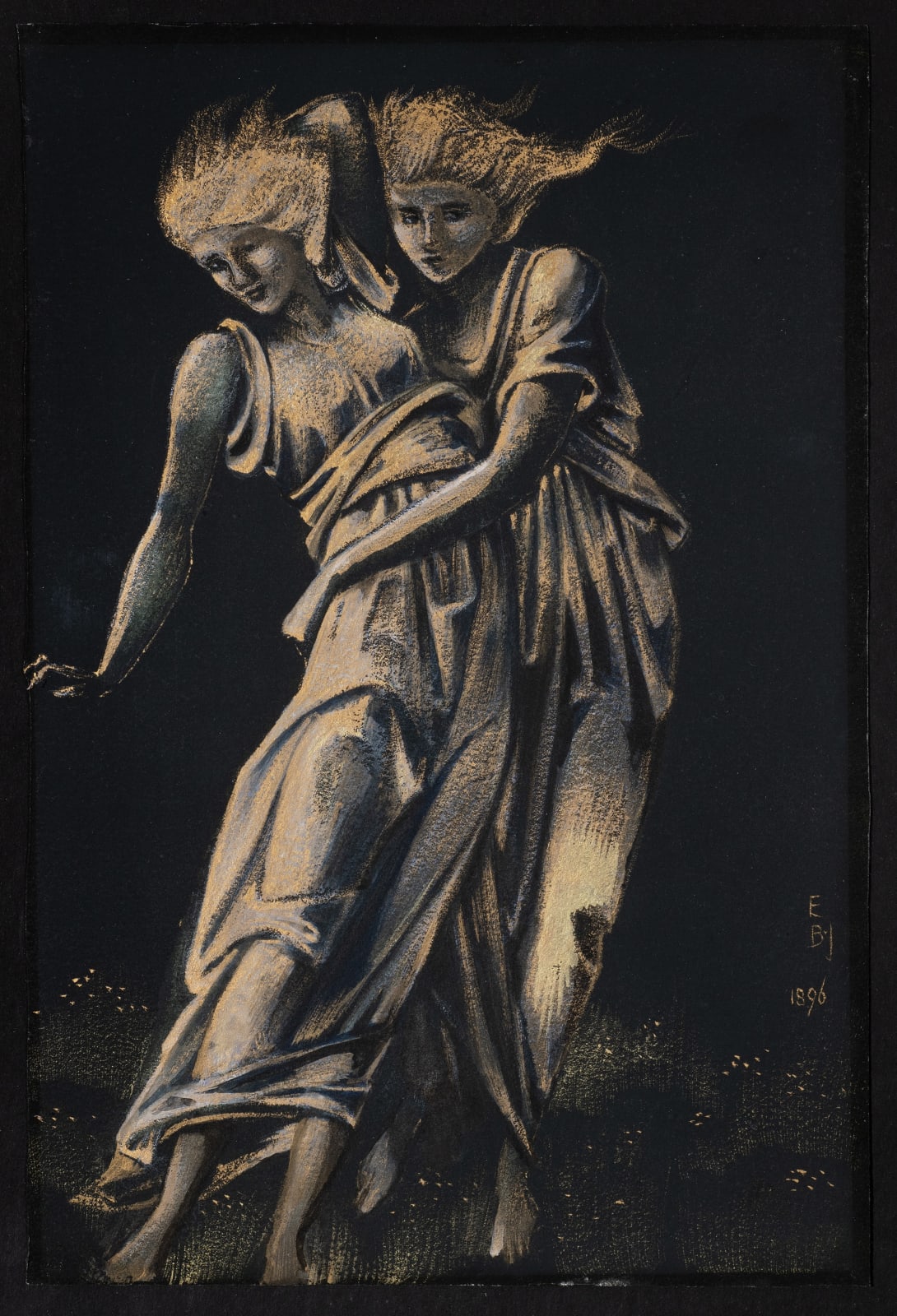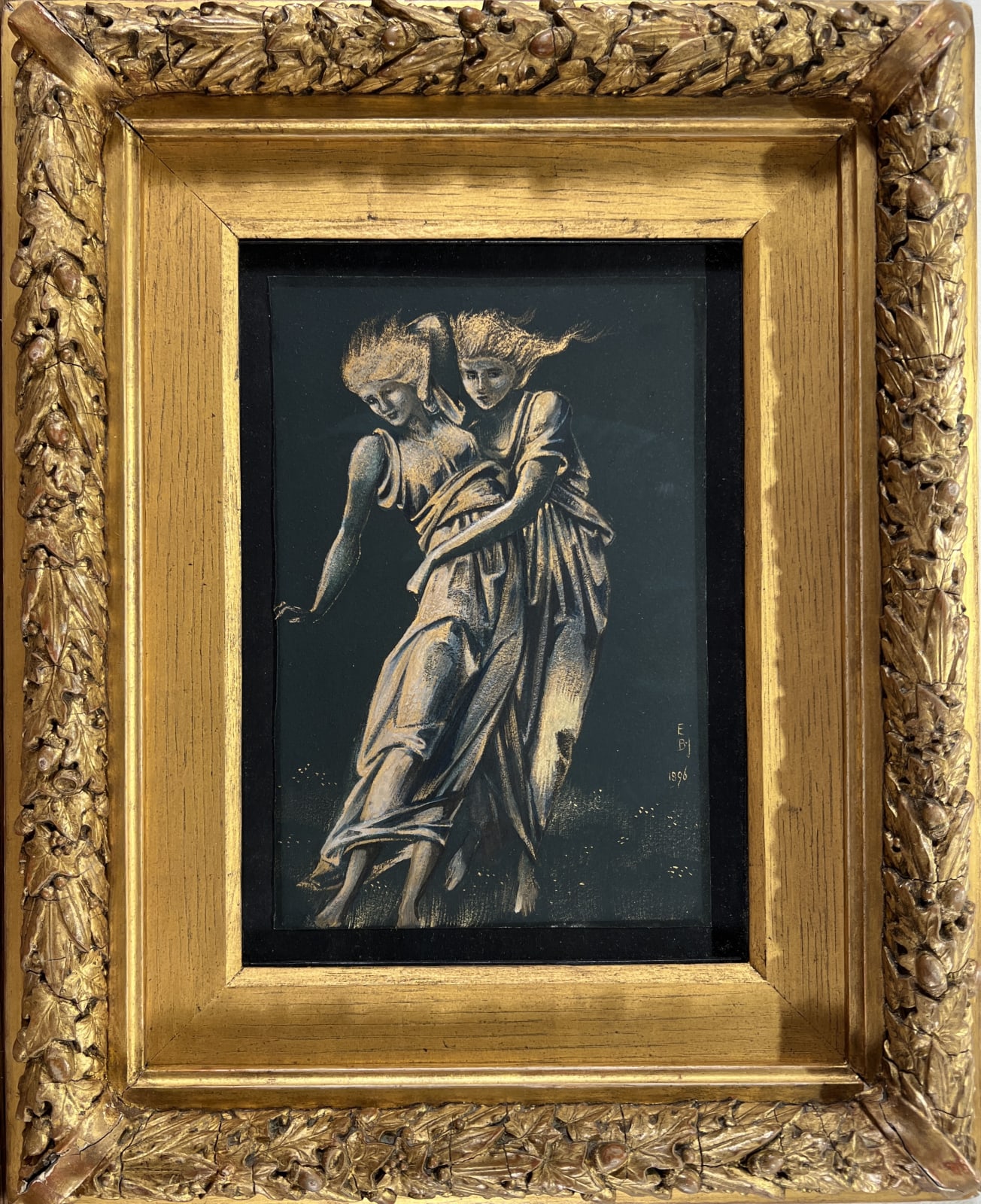Sir Edward Coley Burne-Jones (1833-1898)
Provenance
Lady Georgiana Burne-Jones, 1898
The Artist's Sale, Christie's, July 16, 1898, lot 3
Christie's, London, March 13, 1990, lot 186
Seymour Stein
Sotheby's, The Collecting Eye of Seymour Stein, 11 December 2003, lot 5
Exhibitions
The Works of Sir Edward Burne-Jones, Paris, 1897, no 10
Bermondsey Settlement Picture Exhibition, 1897, lent by the artist
New Gallery, 1898-99, no 203
Literature
Burne-Jones Catalogue Raisonné
Studio Magazine, 1897, vol 9, p 119 for images of some Catterson Smith plaques
In 1897 Burne-Jones’s protégé Robert Catterson-Smith – a silversmith, painter and illustrator – exhibited a hammered silver plaque, now in the Lady Lever Art Gallery, at the Arts and Crafts Exhibition Society at the New Gallery, the opening of which was clouded by the death of William Morris. It was based on a similar design, and showed dancing female figures. It is likely that Burne-Jones made the drawings first, and that Catterson-Smith made his plaques after seeing them. He and Burne-Jones had collaborated before, with Morris, preparing Burne-Jones’s illustrations for the Kelmscott Chaucer (published in 1896 and later described by WB Yeats as ‘the most beautiful of all printed books’). Then a relatively unknown artist, Catterson-Smith worked from photographs of Burne-Jones’s delicate illustrations, tracing over and embellishing them, in order to make them conform to the thick, mediaeval woodcut style designs Morris envisaged for his books. There is another very similar version of this drawing in the Lady Lever Art Gallery, which Stephen Wildman described in the catalogue to the 1998 exhibition Edward Burne-Jones, Victorian Artist-Dreamer: ‘This is a fine example of a particular type of Burne-Jones’s exotic late drawings, in gold on a rich ground, like “the colour of a black poppy” he had admired in a Byzantine Gospel book. Along with another, similar drawing, also formerly in the Lady Lever Art Gallery, it takes up one of the artist’s abiding delights, the effect of clinging drapery on female figures, which he so admired in early Renaissance art’ (pp 331-2). Burne-Jones later drew the same two girls with four others, all dancing, in a larger gold drawing on a purple base, dated 1898. Wildman noted that Burne-Jones ‘was beginning to use gold paint on dark backgrounds on a regular basis as early as 1890, when he made up for exhibiting no oil paintings at the New Gallery by submitting some spectacular works on paper [including] four “Designs in Gold”, one of them on a red ground …. While making one such drawing on April 22, 1897, he inadvertently smudged it, then told Rooke: “This gold work must be done very directly - it’s an art of itself. I forget how I do it between one time and another, and it’s always an experiment.”’ (ibid. pp 330-1)
-
 Frederick Weekes (1833-1920)The Haunted Glen, the Intruder£4,500
Frederick Weekes (1833-1920)The Haunted Glen, the Intruder£4,500 -
 By and Studio of Sir Edward Coley Burne-Jones (1833-1898)Figures on a balconyPOA
By and Studio of Sir Edward Coley Burne-Jones (1833-1898)Figures on a balconyPOA -
 Sir Edward John Poynter (1836-1919)ProserpinePOA
Sir Edward John Poynter (1836-1919)ProserpinePOA -
 William Holman Hunt (1827-1910)Rocks at Wady Zuara, the Dead Sea£3,200
William Holman Hunt (1827-1910)Rocks at Wady Zuara, the Dead Sea£3,200 -
 Sir John Everett Millais (1829-1896)A Wife - Illustration to a Poem, 1859
Sir John Everett Millais (1829-1896)A Wife - Illustration to a Poem, 1859 -
 Dante Gabriel Rossetti (1828-1882)William Bell Scott
Dante Gabriel Rossetti (1828-1882)William Bell Scott -
 Sir Edward Coley Burne-Jones (1833-1898)Study of sleeves for 'The Golden Stairs'£8,500
Sir Edward Coley Burne-Jones (1833-1898)Study of sleeves for 'The Golden Stairs'£8,500 -
 Sir Edward Coley Burne-Jones (1833-1898)Two figures in a landscape
Sir Edward Coley Burne-Jones (1833-1898)Two figures in a landscape -
 Sir Edward Coley Burne-Jones (1833-1898)Philip Burne-Jones, ca. 1875
Sir Edward Coley Burne-Jones (1833-1898)Philip Burne-Jones, ca. 1875 -
 Sir Edward Coley Burne-Jones (1833-1898)Euphrosyne Cassavetti
Sir Edward Coley Burne-Jones (1833-1898)Euphrosyne Cassavetti -
 William Holman Hunt (1827-1910)Eugenie Sellers, Study for 'The Lady of Shalott', c 1895
William Holman Hunt (1827-1910)Eugenie Sellers, Study for 'The Lady of Shalott', c 1895
The Maas Gallery, 6 Duke Street, St. James's, London, SW1Y 6BN
+44 (0) 20 7930 9511 | mail@maasgallery.com
This website uses cookies
This site uses cookies to help make it more useful to you. Please contact us to find out more about our Cookie Policy.














